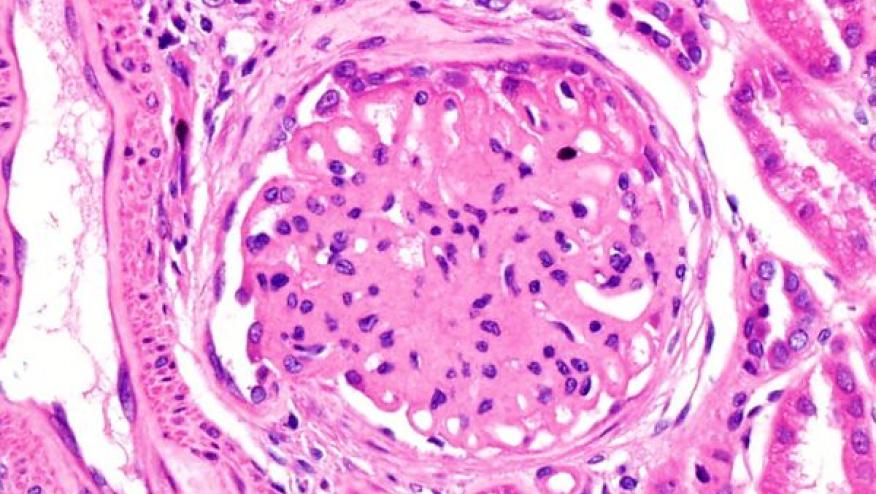Tacrolimus Measures Up in Lupus Nephritis Trial Save

In a phase III trial, oral tacrolimus (Prograf) proved non-inferior to intravenous cyclophosphamide for treating lupus nephritis, researchers said.
Among 158 patients randomized to tacrolimus, 83.0% achieved complete or partial responses after 24 weeks versus 75.0% of 156 assigned to intravenous cyclophosphamide, according to Zhaohui Zheng, MD, of Zhengzhou University in China, and colleagues.
The difference of 7.1 percentage points (95% CI -2.7% to 16.9%) easily met the prespecified criterion for non-inferiority that permitted a lower bound of -15.0% for the confidence interval, the authors reported in JAMA Network Open.
Even better for the trial's sponsor -- Astellas Pharma, whose Prograf brand of oral tacrolimus is currently approved for preventing organ transplant rejection -- the product's safety profile appeared better than that of IV cyclophosphamide.
Rates of serious treatment-emergent adverse events (TEAEs) were numerically lower in the tacrolimus group (18.5% vs 24.6%), as were rates of serious infections considered drug-related (8.9% vs 16.2%). Among serious TEAEs, no particular type was more common with tacrolimus than cyclophosphamide. The same number in each treatment arm (seven) discontinued due to adverse effects.
Conventional initial treatment for lupus nephritis currently includes high-dose corticosteroids and IV cyclophosphamide. However, Zheng and colleagues pointed out, the latter is highly toxic, especially with prolonged treatment. Tacrolimus, though it has its own set of side effects, has appeared as a potentially safer alternative, and more convenient as well. It has already been used off-label in routine practice; a retrospective chart review published in 2018 found generally good outcomes, although some patients were unable to tolerate the drug.
Mechanistically, tacrolimus is hypothesized to relieve lupus nephritis by inhibiting T-cell activation (the same effect underlying its use for graft-rejection prophylaxis) that promotes renal damage, and perhaps also by directly protecting kidney podocytes.
For the current study, an open-label trial conducted in China, the investigators sought to mirror standard practice for cyclophosphamide dosing, with infusions every 4 weeks. The first was at 0.75 g/m2 and then adjusted up or down in 0.25-g/m2 increments to maintain white blood cell counts of 2,500-4,000 per μL.
Tacrolimus was given at 2 mg twice daily at first, with adjustments starting on day 15 if necessary to maintain trough blood levels of 4-10 ng/mL. All patients also received an initial course of IV methylprednisone followed by oral prednisone at customary doses through the full 24-week study.
Patients were Chinese, but in most other respects resembled the global lupus nephritis population: nearly 90% were women, mostly in their 20s and 30s (mean age 34), with about half testing positive for anti-double-stranded DNA (anti-dsDNA) antibodies. Estimated glomerular filtration rate (GFR) averaged 101 mL/min/1.73 m2 at baseline.
The primary efficacy endpoint was response, judged on lab tests for proteinuria, serum albumin, and serum creatinine. Other outcomes evaluated in the study included Systemic Lupus Erythematosus Disease Activity Index (SLEDAI) scores, levels of complement and anti-dsDNA, and overall kidney function.
Higher rates of complete responses (proteinuria <0.5 g/day, serum albumin ≥3.5 g/dL, and serum creatinine either in the normal range or increasing no more than 15% from baseline) drove the primary outcome: 49.6% vs 36.3% with IV cyclophosphamide (P not reported). Rates of partial response were slightly higher in the cyclophosphamide group (38.7% vs 33.3%).
For the individual components of the response assessment, the biggest difference between treatments was for serum creatinine, the investigators' main surrogate for kidney function. Patients receiving tacrolimus showed a mean increase of about 8 μmol/L, whereas the cyclophosphamide group had a mean decrease of about 5 μmol/L (baseline levels averaged just over 70 μmol/L in both groups). There was comparatively little difference in effects on serum albumin, with increases averaging about 14 g/L in both arms, though it was about 10% greater with tacrolimus. Mean proteinuria decreased noticeably more with tacrolimus, by about 4.8 vs 3.6 g/day (from 5.8 and 5.3 g/day, respectively, at baseline).
These differences were evident early (by week 4) and were maintained through the study's end.
SLEDAI scores fell somewhat more with tacrolimus (mean difference -2.2 points at week 24, 95% CI -3.1 to -1.3, from a baseline mean of 12.3); trajectories of complement levels were the same for both drugs, but loss of anti-dsDNA antibodies in patients positive at baseline was somewhat more common with tacrolimus (26% vs 21%). This latter finding suggested a systemic anti-lupus effect, as might be expected from its proposed mechanism, beyond the renal benefits.
Limitations included the trial's lack of blinding, its 24-week duration (Zheng and colleagues conceded that longer follow-up would be useful), and the exclusively Asian patient sample. Also, the investigators chose not to examine whether steroid doses could be reduced with tacrolimus, a potential benefit touted by other researchers.








If you are a health practitioner, you may Login/Register to comment.
Due to the nature of these comment forums, only health practitioners are allowed to comment at this time.